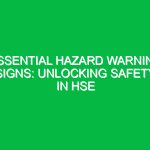Introduction
Hazardous symbols serve as critical visual cues in the Health, Safety, and Environment (HSE) domain. They communicate essential information about potential risks associated with various substances and practices. In a world where Safety is paramount, understanding these symbols is not just important; it’s a necessity. Whether in industrial settings, laboratories, or even households, hazardous symbols guide individuals in recognizing dangers and taking appropriate Precautions.
The relevance of hazardous symbols extends beyond mere compliance; they play a vital role in fostering a culture of Safety. By familiarizing ourselves with these symbols, we can better protect ourselves, our colleagues, and the environment. This article delves into the intricacies of hazardous symbols, exploring their significance, the Regulations that govern their use, and Best Practices for incorporating them into HSE practices.
Understanding Hazardous Symbols
Hazardous symbols, also known as hazard pictograms, are graphical representations designed to convey information about the Hazards associated with chemicals or processes. Each symbol is standardized and universally recognized, making them effective tools for communication in safety practices.
- Globally Harmonized System (GHS): The GHS is an international system that standardizes Hazard Communication, including the use of hazardous symbols. Its adoption has improved safety by providing a consistent approach across borders.
- Classification: Hazardous symbols are classified into categories based on the type of hazard they represent. This includes physical Hazards, health hazards, and environmental hazards.
- Visual Impact: The design of these symbols is intentionally simple and striking, ensuring they catch the eye and convey their message quickly.
Key Hazardous Symbols and Their Meanings
Understanding specific hazardous symbols is crucial for anyone working in environments where such risks are present. Below are some of the most common hazardous symbols:
1. Flame
This symbol indicates flammable materials. It serves as a warning for substances that can easily ignite, leading to Fires or explosions.
2. Skull and Crossbones
This symbol represents acute toxicity. It warns individuals that exposure to the substance can result in severe health consequences or even death.
3. Exclamation Mark
The exclamation mark symbolizes general hazards. It highlights substances that may cause irritation, sensitization, or other health Effects.
4. Corrosion
This symbol indicates corrosive substances that can damage skin, metals, or other materials. It is essential in laboratories and industries dealing with strong acids or bases.
5. Environmental Hazard
This symbol warns of substances that pose a risk to the environment, such as aquatic toxicity. It emphasizes the need for careful handling to prevent ecological harm.
Real-Life Examples of Hazardous Symbols in Action
To illustrate the importance of hazardous symbols, consider a scenario in a chemical manufacturing plant. Employees work daily with various chemicals, including solvents and acids. The presence of clear, visible hazardous symbols on containers helps ensure workers are aware of the risks.
For instance, a container labeled with the corrosion symbol prompts employees to wear appropriate Personal Protective Equipment (PPE), such as gloves and goggles. Ignoring this symbol could result in severe injuries, emphasizing how crucial it is to understand and respect these warnings.
Another example can be found in the agricultural sector. Pesticides often carry the skull and crossbones symbol. Farmers and agricultural workers must understand the implications of this symbol to avoid potential poisoning. Through Training and awareness programs, workers can learn to recognize these symbols, leading to safer practices and reduced accidents.
The Role of Regulations and Standards
Regulations governing hazardous symbols are vital for ensuring safety in various industries. In many countries, organizations like OSHA (Occupational Safety and Health Administration) in the United States and the HSE (Health and Safety Executive) in the UK set forth guidelines on the proper use of hazardous symbols.
Key Regulations Include:
- osha Hazard Communication Standard: This standard requires that hazardous chemicals in the workplace be properly labeled with Hazard Symbols and that employees are informed about the risks associated with these chemicals.
- GHS Implementation: Many countries have adopted the GHS, which mandates the use of standardized hazard symbols for chemicals. This has facilitated safer international trade and improved Workplace Safety.
Compliance with these regulations not only helps protect employees but also minimizes the risk of legal repercussions for organizations. Employers must provide adequate training on understanding and interpreting these symbols, ensuring that workers are well-equipped to handle hazardous materials safely.
Best Practices for Using Hazardous Symbols
Incorporating hazardous symbols effectively into HSE practices requires a proactive approach. Here are some Best Practices to consider:
1. Training and Awareness
Organizations should invest in training programs that educate employees about hazardous symbols. Understanding what each symbol represents is crucial for safety. Regular refresher courses can help maintain awareness over time.
2. Clear Labeling
All hazardous materials should be clearly labeled with their respective symbols. Labels should be easy to read and placed in visible locations. This ensures that individuals can quickly identify potential hazards.
3. Integration into Safety Protocols
Hazardous symbols should be integrated into the organization’s safety protocols. For instance, during safety meetings, discussing relevant symbols in the context of specific tasks can reinforce their importance.
4. Regular Audits
Conducting regular audits of hazardous materials and their labeling can help identify any discrepancies or outdated information. This practice ensures that employees always have access to the most current safety information.
Potential Hazards and Risks Related to Hazardous Symbols
While hazardous symbols aim to enhance safety, the failure to recognize or understand them can result in significant risks. Common hazards associated with improper handling of hazardous materials include:
- Chemical Burns: Lack of awareness of corrosive symbols can lead to severe chemical burns.
- Poisoning: Ignoring toxicity symbols can result in accidental poisoning, particularly in environments where workers handle various chemicals.
- Environmental Damage: Failure to recognize environmental hazard symbols can lead to ecological disasters, such as spills in water bodies.
Real-life incidents highlight the consequences of neglecting hazardous symbols. For instance, a chemical spill due to improper handling of a corrosive substance can lead to workplace injuries and environmental contamination. These incidents underscore the importance of adhering to Safety Guidelines and recognizing hazardous symbols.
Conclusion
In summary, hazardous symbols are indispensable tools in the HSE domain, providing crucial information about potential risks associated with various substances and practices. By understanding and respecting these symbols, individuals can significantly enhance safety in their workplaces and daily lives.
As regulations evolve and industries adopt more stringent safety practices, the importance of hazardous symbols will only continue to grow. Organizations must prioritize training, clear labeling, and the integration of these symbols into safety protocols to foster a culture of safety.
Ultimately, the goal is to create an environment where everyone is aware of the hazards they face and understands the steps they need to take to protect themselves and the environment. By unlocking the power of hazardous symbols, we can pave the way for safer workplaces and communities, ensuring that health, safety, and environmental Sustainability remain at the forefront of our practices.


